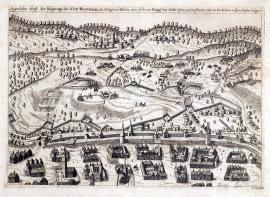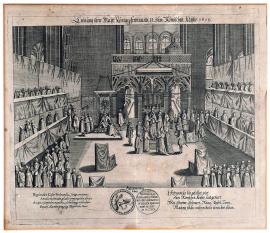Engravings of the year 1619

An actual picture of the siege of Budejovice in the Czech kingdom occupied by the royalty and the Czechs in 1619.
At the front in the engraving is the town of Budejovice with walls, towers and gates, and in the background is a hilly panorama with trees, the military troops, the artillery, and the individual soldiers. The picture makes an impression of the town being only watched and experiencing only small raids against the fortress rather than the actual siege. The terrain outside the town indicates that the combat was targeted in the direction out of the town, which points to the estates’ armies not acting too belligerently.

The mirror of Czech restlessness, on which there are various and special depictions of all acts of the uprising and all violence as they took place in the lapsed year 1618 until that day in the famous Czech kingdom.
It is a set of two small pictures depicting scenes representing the course and the characteristics of the political and religious events as they took place in Bohemia from 1618 to 1619. There is, for example, the scene where the fox and the wolf “in sheep’s clothing” are approaching the Czech wolf to persuade it of the dangers associated with the Evangelic religion. Other picture shows the cardinal Khesel and some Jesuit who are holding the canvas before the emperor Matthew sitting on the throne in order to prevent him looking at the arriving envoy who wants to present the requirements and complaints of the Czech estates. In the middle is a bigger picture with a big furnace heated by many Jesuits called as “superbia, arrogantia, avaritia”, etc. A small angel “providentia” is pouring water into the fire. This scene is satirical about the anti-reformation led, in particular, by the Jesuits. Under the picture is a very detailed legend explaining the depicted events. Nearly all persons are marked with letters and the legend always states accurately who is depicted and by whom which statement was expressed.

The coronation of His Majesty, king Ferdinand II, the Roman emperor in 1619.
The engraving depicts the act of coronation on 9 September 1619 in Frankfurt am Main. On Wednesday, the king is kneeling by the altar and the Koln archbishop is putting the crown on his head. They are surrounded by dignitaries holding the sword, the sceptre and the imperial apple. On the next field another scene is depicted: the king sitting on the throne under the imperial eagle is dubbing several men; on the sides there are tribunes from which crowd is observing the act. Under the picture on the right there is the following text: Ferdinandus hier gesalbt wirt zum Röm. Kayser und geziert mit Scepter, Schwert, Ring, Apfel, Cron, Mayntz solchs mehrentheils verrichtet schon. On the other side is the same text in Latin. In the middle under the picture are coins scattered amongst people (ausgeworfene Münz) on the occasion of the coronation. The coin is a hand partially covered by the clouds and holding the crown. On the hand is a ribbon with the inscription: “Legitime certantibus”. On the back side of the coin is the inscription: “Ferdinandus secundus Hungariae et Bohemiae Rox coronatus in reegem Romanorum, IX. Sept. MDCXIX”.

The unction (confirmation) and coronation of the grace and high-dynasty nobleman, prince Frederick V from Palatinate am Rhine, duke of Upper and Lower Bavaria and elector, as the Czech king.
The picture is divided into 9 fields in which the individual acts of coronation are depicted in detail: A. The welcome ceremony in the Hvězda castle in White Mountain. B. The arrival in Hradčany. C. The ceremonial procession towards the place of coronation. D. The king’s unction. E. The coronation. F. The Czech estates’ oath to the king. G. The king is dubbing lower nobility representatives. H. The depiction of coins minted on the occasion of the coronation. I. The ceremonial lunch after the coronation. – Under the picture is an extensive text describing the whole event in detail and legend A-I.


